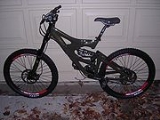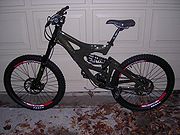
Downhill bike
Encyclopedia

Bicycle suspension
A bicycle suspension is the system or systems used to suspend the rider and all or part of the bicycle in order to protect them from the roughness of the terrain over which they travel...
bicycle
Bicycle
A bicycle, also known as a bike, pushbike or cycle, is a human-powered, pedal-driven, single-track vehicle, having two wheels attached to a frame, one behind the other. A person who rides a bicycle is called a cyclist, or bicyclist....
designed for downhill cycling
Downhill cycling
Downhill biking is a gravity-assisted time trial mountain biking event. Riders race against the clock, usually starting at intervals of 30 seconds , on courses which typically take two to five minutes to complete. Riders come from all around the world. Riders are timed with equipment similar to...
on particularly steep, rocky trails. Unlike a typical mountain bike, durability and stability are the most important design features, compared to lighter, more versatile cross-country
Cross-country cycling
Cross-country cycling is the most common discipline of mountain biking. While less publicized than downhill cycling as it is more difficult to televise, it garners the highest levels of participation both recreationally and competitively....
bikes. Downhill bikes are primarily intended for high speed descent, and downhill riders will usually push, or shuttle via chairlifts or motorized vehicles, to the trailhead.
Downhill bikes are typically made of aluminum or steel, will have 7-10 inches (180-250mm) of rear suspension travel, and be designed around a 7-8 inch (180-203mm) suspension fork
Bicycle fork
A bicycle fork is the portion of a bicycle that holds the front wheel and allows the rider to steer and balance the bicycle. A fork consists of two fork ends which hold the front wheel axle, two blades which join at a fork crown, and a steerer or steering tube to which the handlebars attach ...
. The suspension sag is also much higher than cross-country bikes (25%-50% of total travel vs. 10%-20%) for a more supple ride at higher speeds.
These bikes will also have very slack head tube angles (66 degrees or less), long wheelbases (over 45 inches), and will accommodate the use of up to 3 inch width knobbed tires. Downhill frames are also overbuilt to handle the stress of riding over rocky terrain, drops, and jumps
Dirt Jumping
Dirt jumping is one of the names given to the practice of riding bikes over cement type jumps of dirt or soil and becoming airborne. The idea is that after riding over the 'take off' the rider will become momentarily airborne, and aim to land on the 'landing'.Dirt jumping can be done on almost...
. Bike weights have been typically over 40 lbs (18 kg), but modern downhill bikes have broken the 45 lb weight barrier (such as the Trek Session 10, weighing in at almost 50 lbs). Some newer (2007/8) downhill bikes can be built to weigh under 38 lbs, such as the Santa Cruz V10 or the GT DHi and also the Full Carbon Lahar
Other features include 8 inch (203mm) disc brakes and a chain guide to prevent accidental chain deraillment. Other innovations include the use of OnePointFive head tube
Head tube
Most bicycles, tricycles and motorcycles have a tubular frame. The front fork pivots within the head tube . On a motorcycle, the "head tube" is normally called the steering head...
standard, which uses a 1.5" wide head tube (see headset
Headset (bicycle part)
The headset is the set of components on a bicycle that provides a rotatable interface between the bicycle fork and the head tube of the bicycle frame itself. The short tube through which the steerer of the fork passes is called the head tube. A typical headset consists of two cups that are pressed...
), instead of the more conventional 1.125" diameter, for added stiffness and strength. Adjustable head tube angles are also available to adapt the bike to the owner's preferred style of riding.
Downhill bikes are also very similar to freeride bikes due to large strong frames and long travel. Most downhill bikes use triple clamp forks which allow longer travel at the front(usually 203mm/8in) and increased stiffness that a single crown fork cannot offer. Drawbacks though, are increased weight and reduced turning circle.

